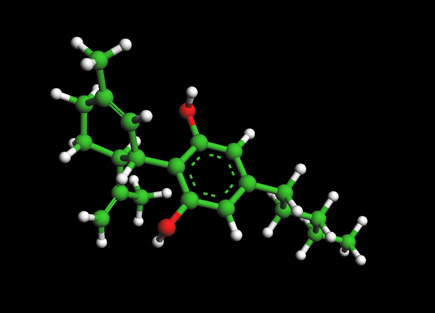Zoloft Molecule - Sertraline

Ball and Stick Model for Molecule - Zoloft Molecule - Sertraline
To View the Zoloft Molecule in 3D --->>in 3D with Jsmol

Sertraline Molecular Structure
Sertraline, is under the trade name Zoloft. Sertraline is a selective serotonin reuptake inhibitor (SSRI) that acts by blocking the reuptake of serotonin in CNS synaptic clefts, thus increasing serotonin levels in the brain which is associated with its psychiatric effects. Sertraline was approved for use in the United States in 1991, and it remains in wide use, with almost 40 million prescriptions being filled yearly. Indications for sertraline include major depression, obsessive-compulsive disorder, panic disorder, and major anxiety disorders including social anxiety, post-trauma stress and generalized anxiety disorder. Sertraline is also used for headache, premenstrual dysphoric disorder, diabetic neuropathy and premature ejaculation. Sertraline is available as tablets of 25, 50 and 100 mg and as an oral suspension in multiple generic forms and under the brand name of Zoloft. The recommended dosage for depression in adults is 50 or 100 mg once daily, increasing the dosage by 25 or 50 mg increments to a maximum of 200 mg. Common side effects are drowsiness, dyspepsia, nausea, headache, increased sweating, increased appetite, weight gain and sexual dysfunction. Sertraline should not be used together with MAO inhibitor medication.
About Serotonin
Serotonin is a biochemical messenger and regulator, synthesized from the essential amino acid L-Tryptophan. Serotonin in the nervous system acts as a local transmitter at synapses, and as a paracrine or hormonal modulator of circuits upon diffusion, allowing a wide variety of "state-dependent" behavioral responses to different stimuli. Serotonin is widely distributed in the nervous system of vertebrates and invertebrates and some of its behavioral effects have been preserved along evolution. Such is the case of aggressive behavior and rhythmic motor patterns , including those responsible for feeding. In vertebrates, which display a wider and much more sophisticated behavioral repertoire, serotonin also modulates sleep, the arousal state , sexual behavior, and others, and deficiencies of the serotonergic system causes disorders such as depression, obsessive-compulsive disorder, phobias, posttraumatic stress disorder, epilepsy, and generalized anxiety disorder. Serotonin has three different modes of action in the nervous system: as transmitter, acting locally at synaptic boutons; upon diffusion at a distance from its release sites, producing paracrine (also called volume) effects, and by circulating in the blood stream, producing hormonal effects. The three modes can affect a single neuronal circuit.
References
Selective serotonin reuptake inhibitors (SSRIs)
Molecules of Life Resources
The Cannabidiol Molecule
Cannabidiol (CBD is the major non-psychoactive component of Cannabis and is being looked at by major drug and consumer companies for various medical and social uses.